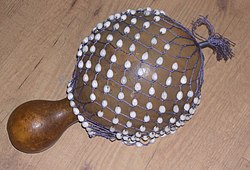 Shekere Shekere | |
| Percussion instrument | |
|---|---|
| Other names | Ṣẹ̀kẹ̀rẹ̀ |
| Classification | Percussion |
| Hornbostel–Sachs classification | idiophone |
| Related instruments | |
| Afoxé, Abwe | |
| Musicians | |
| Madeleine Yayodele Nelson | |
The shekere (from Yoruba Ṣẹ̀kẹ̀rẹ̀) is a percussion instrument consisting of a dried gourd with beads or cowries woven into a net covering the gourd. There are multiple ways to produce sounds with the instrument. It can be shaken or hit against the hand. The instrument can also rest in the palm of one hand while other hand holds the handle of the gourd. A twisting wrist motion is used so that the gourd moves while beads remain in place causing friction and sound different than when the instrument is simply shaken or struck. The shekere originated in Yorubaland West Africa, which comprises the countries of Nigeria, Benin, and Togo.
While originating with the Yoruba people, the instrument is common throughout West Africa and Latin America and is central to folk music traditions of many cultures as well as well as being utilized within some popular music styles. In Ghana the instrument is referred to as axatse. In Latin America the instrument is commonly known as cabaça. Other names for the instrument include afuxê, afoxé, cabaca, cabasa, and cabaza depending on the language and culture.
The shekere is made from vine gourds that grow on the ground. The shape of the gourd determines the sound of the instrument. A shekere is made by drying the gourd for several months then removing the pulp and seeds. After it is scrubbed, skillful bead work is added as well as colour.
Varieties
In Cuba, the chekeré, also known as aggué (abwe), is a large, hollow gourd (~50 cm long, approx. 19+1⁄2 in) almost entirely surrounded by a network of cords, to which many coloured beads are attached. Widely used in Afro-Cuban sacred and popular music, it may be twisted, shaken or slapped producing a subtle variety of effects; musically, it is more flexible than maracas.
In Brazil, this African gourd rattle is called a xequerê. It consists of the gourd (cabaça) cut in the middle and then wrapped in a net in which beads or small plastic balls are threaded. The afoxé is a similar, smaller instrument.

Problems playing this file? See media help.
References
- Crowther, Samuel Ajayi (1852). "Ṣẹ́kẹrẹ". A vocabulary of the Yoruba language. p. 264. OCLC 1102117470. Retrieved 7 June 2022.
- "How A Gourd Shekere Is Made". X8 Drums. 8 July 2014. Archived from the original on 30 May 2013. Retrieved 7 June 2022.
- Blades, James; Holland, James (2001). "Cabaça ". Cabaça. Grove Music Online. Oxford University Press. doi:10.1093/gmo/9781561592630.article.04498. ISBN 978-1-56159-263-0.
- Orovio, Helio (12 March 2004). Cuban Music from A to Z. Duke University Press. p. 52. doi:10.2307/j.ctv11smscb. ISBN 978-0-8223-8521-9.
- Ortiz, Fernando (1952). Los instrumentos de la música Afrocubana (in Spanish). Vol. 2. Dirección de Cultura del Ministerio de Educación. p. 124. OCLC 603651385.
External links
Categories:- Unpitched percussion instruments
- West African musical instruments
- Bissau-Guinean musical instruments
- Brazilian percussion
- Burkinabé musical instruments
- Cuban musical instruments
- Gambian musical instruments
- Guinean musical instruments
- Ivorian musical instruments
- Malian musical instruments
- Senegalese musical instruments
- Idiophones
- Gourd musical instruments